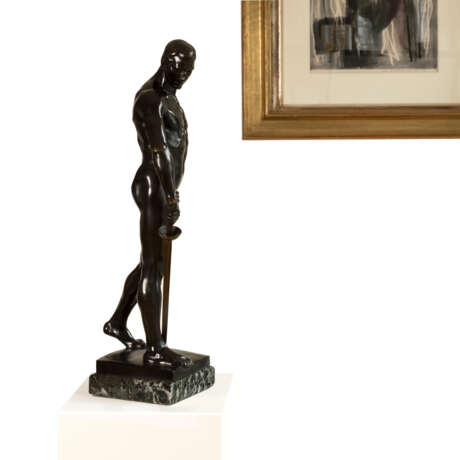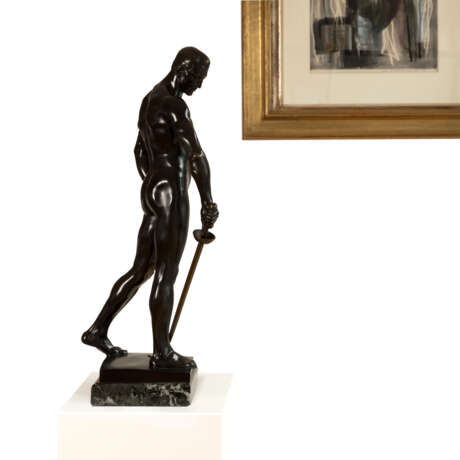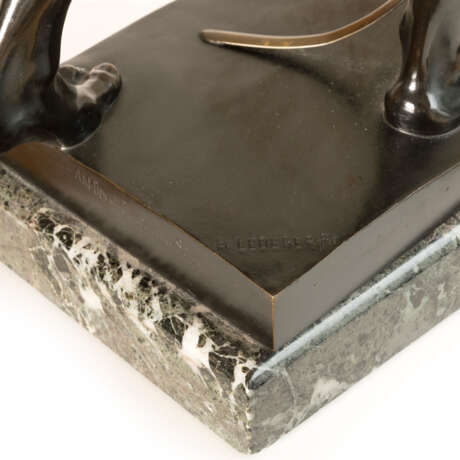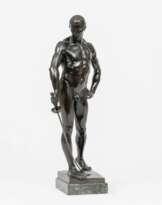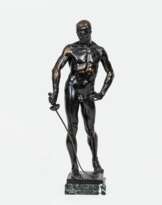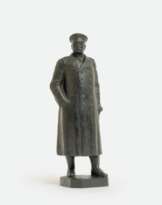ID 1066824
Lot 27 | Hugo Lederer (1871 Znaim, Tschechien - 1940 Berlin)
Estimate value
€ 1 400 – 2 200
Hugo Lederer (1871 Znaim, Tschechien - 1940 Berlin)
'Fechter', Bronze, dunkelbraun patiniert, auf Marmorsockel, Höhe (mit Sockel) 57,5 cm, im Guss 'H. LEDERER Fec' signiert, Gießerstempel 'Akt-Ges vH. Gladenbeck &, Sohn', partiell leichte oberflächliche Kratzer, Marmorsockel bestoßen, Literatur: Ausst. Kat. Berlin 1936, Berliner Bildhauer von Schlüter bis zur Gegenwart, Preussische Akademie der Künste, Berlin 1936, Tafel 18, mit Abb. (anderes Exemplar)
Hugo Lederer (1871-1940) war ein deutscher Bildhauer und Medailleur des späten 19. und frühen 20. Jahrhunderts und zählt zu den bedeutendsten und produktivsten Bildhauern der Wilhelminischen Ära. Nach seiner Ausbildung in Znaim ließ sich der Künstler 1895 als freier Bildhauer in Berlin nieder. Lederer schuf nicht nur zahlreiche Porträtbüsten prominenter Persönlichkeiten, sondern auch zahlreiche monumentale Skulpturen für den öffentlichen Raum. Der hier angebotene "Fechter" wurde maßgeblich von der im Jahr 1901 ausgeschriebenen Konkurrenz für einen Universitätsbrunnen in Breslau inspiriert. Obwohl Lederers Entwurf nur mit dem zweiten Preis ausgezeichnet wurde, erhielt er dennoch den Auftrag zur Ausführung. Der sogenannte 'Fechterbrunnen' wurde vor dem Kaisertor der Breslauer Universität aufgestellt und am 26. November 1904 feierlich enthüllt. Der Brunnen besteht aus einem großen, runden Marmorbecken, in dessen Mitte sich ein kleineres Marmorbecken befindet. Dieses kleinere Becken wird von zwei weiblichen Aktfiguren getragen, als Ausguss dienen vier stilisierte Masken. Die Krönung des Brunnens erfolgt durch eine überlebensgroße Bronzeplastik eines Fechters. Im Breslauer Volksmund erhielt dieser Brunnen den Spitznamen "Säbeljürge". Später wurden lebensgroße Nachgüsse des Brunnens an verschiedenen Orten platziert. Darüber hinaus gibt es auch verkleinerte Gussversionen des Fechterbrunnens. Die verschiedenen Ausführungen zeugen von der anhaltenden Wertschätzung und Bedeutung dieses Kunstwerks.
Hugo Lederer (1871 Znojmo, Czech Republic - 1940 Berlin)
'Fencer', bronze, dark brown patinated, on a marble base, height (with base) 57.5 cm, cast 'H. LEDERER Fec' signed, foundry stamp 'Akt-Ges vH. Gladenbeck &, Sohn', some slight superficial scratches, marble base chipped, literature: exh. Cat. Berlin 1936, Berlin sculptors from Schlüter to the present, Prussian Academy of Arts, Berlin 1936, plate 18, with illustration (other copy)
Hugo Lederers was a German sculptor and medalist and is one of the most important and productive sculptors of the Wilhelmine era . After his training in Znojmo, Lederer settled in Berlin in 1895 as a freelance sculptor and created important monuments such as the Bismarck monument in Hamburg (1902/06), the Heine monument in Hamburg's city park (melted down in 1943) and the equestrian monument to Emperor Friedrich III. in Aachen. In 1901, the city of Breslau announced a competition for a university fountain. Although only awarded second prize, Hugo Lederer's design was implemented. The fountain features a large round marble basin. In the middle there is a smaller marble basin, supported by two female nude figures, with four stylized masks as a spout. The fountain is crowned by a bronze swordsman. The unveiling of the fountain, which was set up in front of the Imperial Gate of the University of Breslau, took place on November 26, 1904. In the Breslau vernacular, this fountain was called ''Säbeljürge'', in contrast to the ''Gabeljürge'', the Neptune fountain on the Neumarkt.
| Artist: | Hugo Lederer (1871 - 1940) |
|---|---|
| Auction house category: | Figures and sculptures |
| Artist: | Hugo Lederer (1871 - 1940) |
|---|---|
| Auction house category: | Figures and sculptures |
| Address of auction |
WETTMANN | Auktionshaus an der Ruhr Friedrichstraße 67-67a 45468 Mülheim an der Ruhr Germany | ||||||||||||||
|---|---|---|---|---|---|---|---|---|---|---|---|---|---|---|---|
| Preview |
| ||||||||||||||
| Phone | +49 (0)208 3059081 | ||||||||||||||
| Fax | +49 (0)208 4391735 | ||||||||||||||
| Buyer Premium | 30% | ||||||||||||||
| Conditions of purchase | Conditions of purchase | ||||||||||||||
| Business hours | Business hours
|

